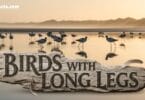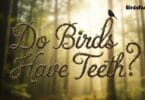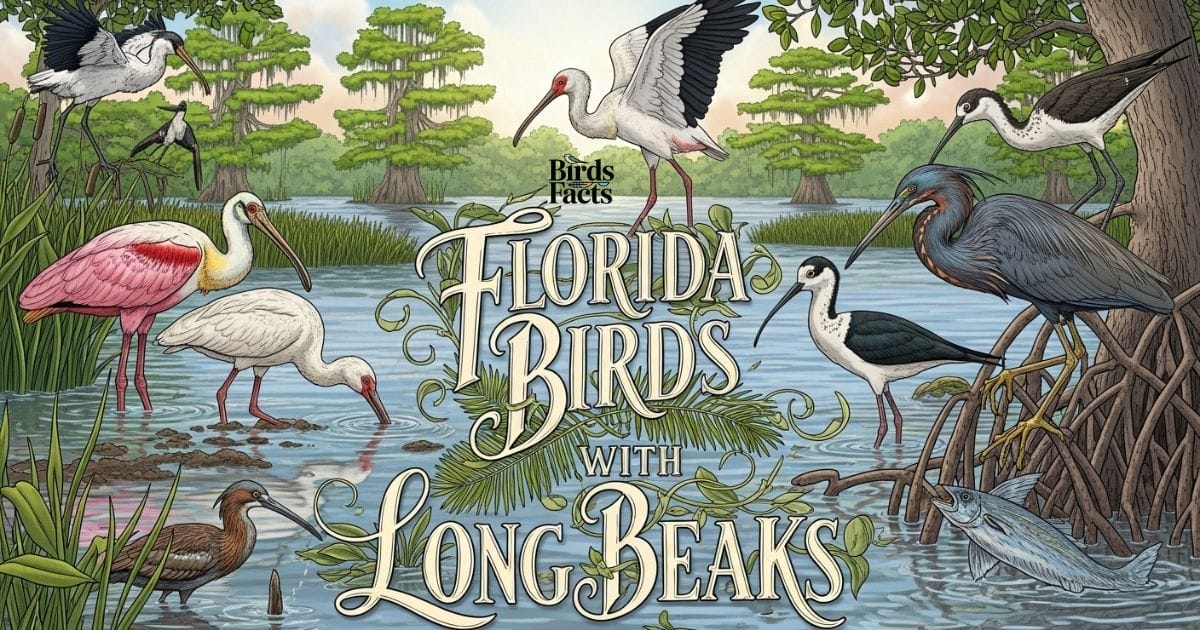
Florida Birds With Long Beaks Top 35 Species You Need To See
You’re Walking Along A Shoreline When You Suddenly Spot A Bird With A Beak So Long It Almost Looks Unreal. You Pull Out Your Phone To Figure Out What It Is But Every Search Just Leaves You Guessing. It’s A Little Frustrating Right You Know Florida Is Full Of Amazing Wildlife But Identifying Florida Birds With Long Beaks Shouldn’t Feel Like Solving A Puzzle. Sometimes You’re Walking Along A Florida Shoreline Or Sitting Quietly In A Park And You Spot One That Takes Your Breath Away.
That’s Exactly Why This Guide Exists To Take Away The Guesswork And Help You Spot These Incredible Florida Birds With Long Beaks With Confidence. From Elegant Waders To Speedy Fish Hunters Each Species Has Its Own Charm And Purpose. We’ll Explore Where To Find Them What They Eat And The Unique Ways They Use Their Beaks In The Wild.
American White Pelican

American White Pelican With Large Orange Beak And White Feathers Near Water
American White Ibis
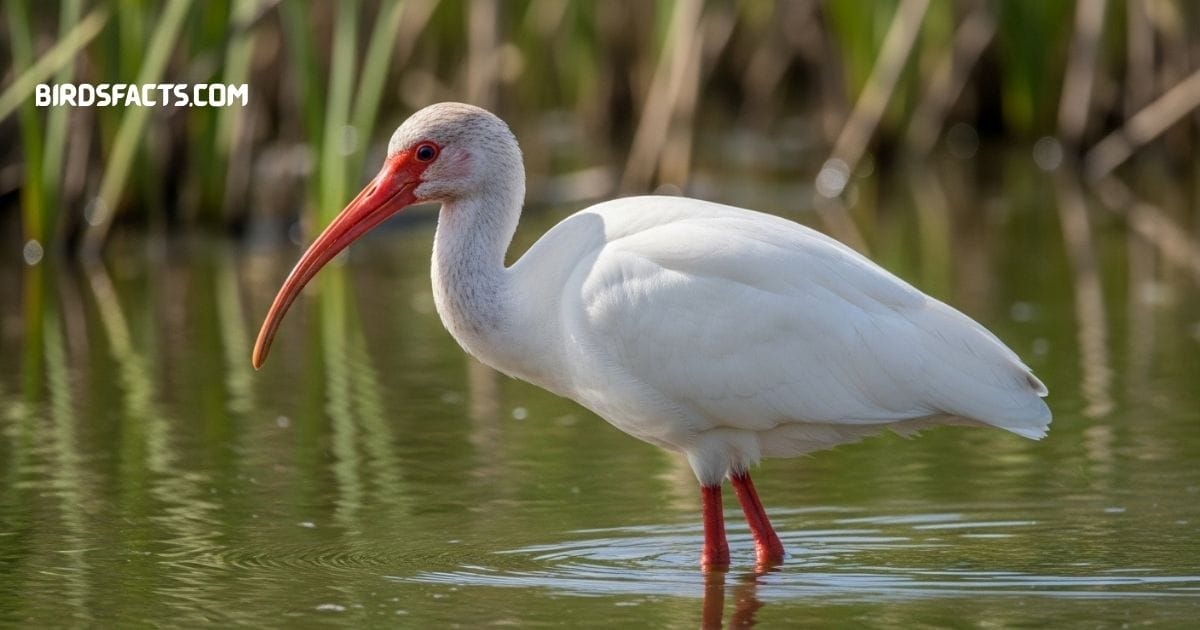
Merican White Ibis With Long Curved Orange Beak And White Body Wading In Shallow Water
The American White Ibis Is A Common Sight In Florida’s Wetlands Coastal Marshes And Even Suburban Parks. It’s Easy To Recognize Thanks To Its Long Downward Curving Orange Bill White Plumage And Black Wingtips Visible In Flight. This Bill Is Perfectly Adapted For Probing Into Mudflats And Shallow Waters To Extract Aquatic Prey Such As Crustaceans Insects And Small Fish.
Among Florida Birds With Long Beaks The American White Ibis Stands Out For Its Graceful Foraging And Distinctive Curved Bill. These Resident Birds Are Often Seen Foraging In Groups Moving Methodically Across Grassy Or Muddy Terrain. Their Foraging Behavior Plays A Vital Role In Controlling Insect Populations And Maintaining Wetland Health. During The Breeding Season Their Bill And Facial Skin Take On A Deeper Reddish Hue Adding To Their Visual Appeal And Making Them One Of The Most Recognizable Florida Birds With Long Beaks In The State.
| Fact | Detail |
|---|---|
| Range | Found In The Southeastern United States Central America And Northern South America |
| Key Fact | Wading Bird Easily Recognized By Its Long Downcurved Red Bill And White Plumage |
| Plumage | Pure White Body With Black Wing Tips Red Face Legs And Bill |
| Behavior | Often Seen In Flocks Foraging In Shallow Water Or Fields Using Their Bills To Probe For Food |
| Diet | Feeds On Crustaceans Insects Small Fish And Other Aquatic Invertebrates |
Anhinga
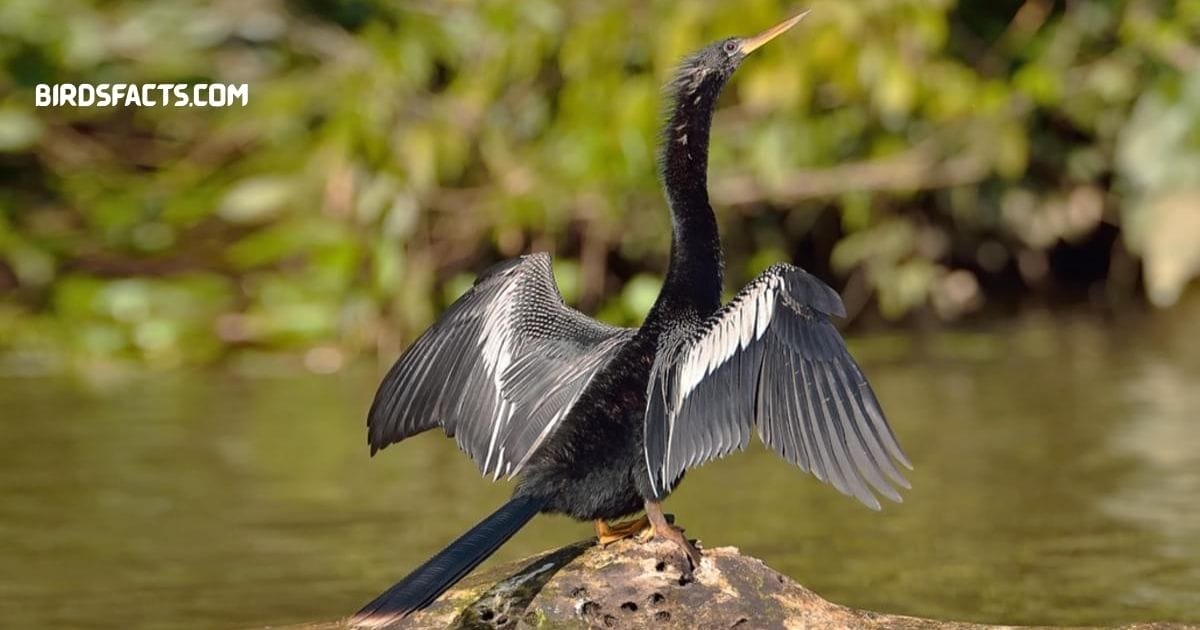
Anhinga Bird With Long Slender Neck And Sharp Pointed Beak Drying Wings Near Water
| Fact | Detail |
|---|---|
| Range | Found In The Southeastern United States Central America South America And The Caribbean |
| Key Fact | Also Known As The Snakebird Because Its Long Neck Resembles A Snake When Swimming |
| Plumage | Black Body With Silver Wing Streaks Males Are Darker While Females Have Brownish Necks |
| Behavior | Swims With Body Submerged And Dries Wings By Spreading Them In The Sun |
| Diet | Feeds Mainly On Fish Speared Underwater With Its Sharp Bill |
American Purple Gallinule

American Purple Gallinule With Bright Purple Plumage, Red And Yellow Beak, Walking On Lily Pads
The American Purple Gallinule Is A Tropical Gem With Iridescent Purple Blue Plumage A Bright Red Bill Tipped In Yellow And Impossibly Long Yellow Legs. While Its Beak Isn’t As Long As Some Wading Birds It’s Still Well Suited For Plucking Plant Material And Insects From Marsh Vegetation. Among Florida Birds With Long Beaks The Gallinule Stands Out For Its Brilliant Colors And Unique Ability To Walk Gracefully On Floating Lily Pads A True Marvel Of Adaptation.
Found In Florida’s Marshes Wetlands And Freshwater Lakes The Purple Gallinule Feeds On A Varied Diet From Seeds And Fruit To Aquatic Invertebrates. During The Breeding Season Its Colorful Appearance Becomes Even More Vibrant Making It A Favorite Among Birdwatchers And A Photogenic Highlight Among Florida Birds With Long Beaks Across The State.
| Fact | Detail |
|---|---|
| Range | Found In The Southeastern United States Central America The Caribbean And Northern South America |
| Key Fact | Known For Its Bright Colors And Ability To Walk Gracefully On Floating Vegetation |
| Plumage | Iridescent Purple Blue Body With Green Back Red Bill Tipped With Yellow And Bright Yellow Legs |
| Behavior | Active And Agile Often Seen Climbing On Lily Pads And Reeds While Foraging |
| Diet | Feeds On Seeds Fruits Insects And Small Aquatic Creatures |
American Oystercatcher
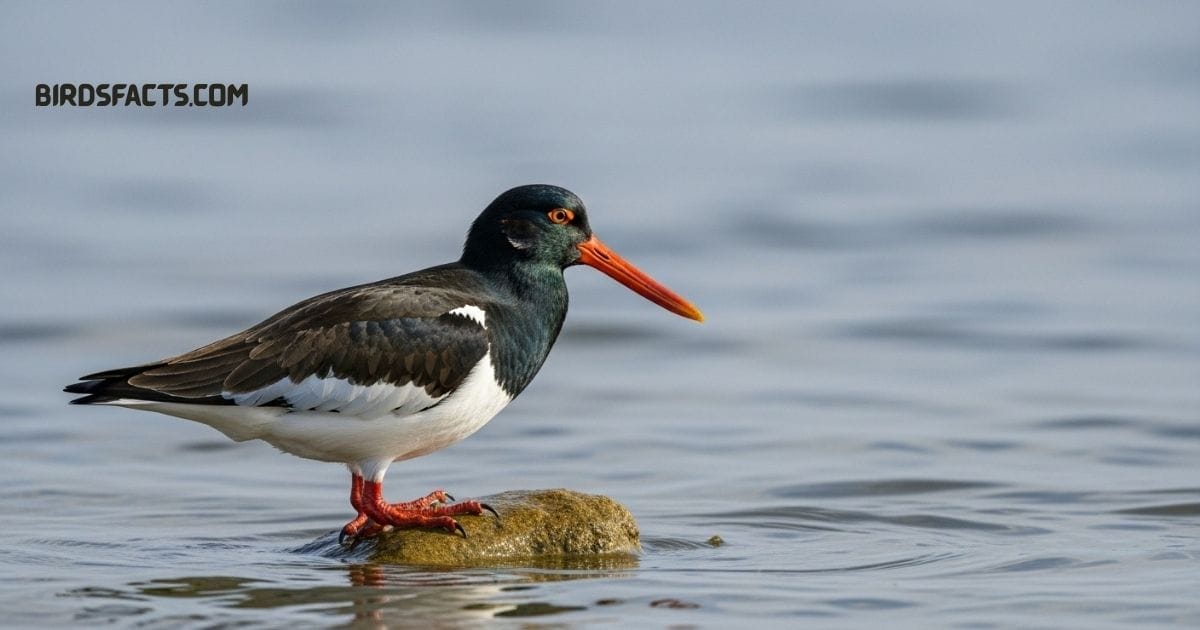
The American Oystercatcher Is A Coastal Specialist With A Striking Black And White Body Bright Yellow Eyes And An Unmistakable Long Orange Bill. True To Its Name It Uses That Bill To Pry Open Shellfish Like Oysters And Clams Along Mudflats And Tidal Flats. Among Florida Birds With Long Beaks The Oystercatcher Is One Of The Most Distinctive Hunters Perfectly Designed For Its Coastal Lifestyle.
They Are Typically Seen Along Sandy Shores Barrier Islands And Estuaries In Florida. Due To Habitat Loss These Birds Are Considered A Threatened Species In Some Regions Making Every Sighting An Important Reminder To Protect Coastal Ecosystems. Their Bright Colors And Precise Feeding Techniques Make Them A Symbol Of The Beauty And Fragility Found Among Florida Birds With Long Beaks.
| Fact | Detail |
|---|---|
| Range | Found Along The Atlantic And Gulf Coasts Of North America As Well As Parts Of The Caribbean And South America |
| Key Fact | Shorebird Easily Recognized By Its Bright Orange Red Bill Used To Pry Open Shellfish |
| Plumage | Black Head White Underside And Brown Back With Striking Orange Bill And Yellow Eyes |
| Behavior | Often Seen Along Sandy Beaches And Mudflats Probing For Shellfish At Low Tide |
| Diet | Feeds Mainly On Oysters Clams Mussels And Other Marine Invertebrates |
American Avocet

American Avocet With Slender Upturned Beak, Long Legs, And Black-and-white Wings Wading In Shallow Water
With Its Slender Upturned Bill The American Avocet Is A Graceful Wading Bird That Sweeps Its Beak Side To Side Through Shallow Waters In Search Of Aquatic Prey. Its Striking Plumage Shifts Between A Rusty Head And Neck In Breeding Season And A Clean Gray And White Look In The Non Breeding Season. Among Florida Birds With Long Beaks The Avocet Stands Out For Its Elegance And Unique Feeding Motion That Looks Almost Like A Dance In The Water.
As They Feed In Groups These Migrating Birds Can Often Be Seen In Coastal Habitats Such As Lagoons And Saltwater Marshes During Migration Periods. Their Long Legs And Distinctive Silhouette Make Them One Of The Most Elegant Florida Birds With Long Beaks Gliding Gracefully Across The Shallows During Their Journey.
| Fact | Detail |
|---|---|
| Range | Found In Western And Central North America Breeding In Shallow Wetlands And Migrating To Coastal Areas For Winter |
| Key Fact | Graceful Wading Bird Recognized By Its Upturned Bill And Striking Black And White Plumage |
| Plumage | White Body With Black Wings And Cinnamon Head And Neck During Breeding Season |
| Behavior | Feeds By Sweeping Its Upturned Bill Side To Side Through Shallow Water To Catch Invertebrates |
| Diet | Feeds On Aquatic Insects Crustaceans And Small Fish |
American Flamingo

American Flamingo With Bright Pink Feathers And Long Curved Beak Standing In Shallow Water
| Fact | Detail |
|---|---|
| Range | Found In The Caribbean Northern South America And Along The Yucatán Peninsula Of Mexico |
| Key Fact | Tall Wading Bird Known For Its Bright Pink Plumage And Long Curved Neck And Legs |
| Plumage | Vibrant Pink To Reddish Feathers With Black Wing Tips And Large Downward Curved Bill |
| Behavior | Highly Social Often Seen In Large Flocks Feeding And Performing Synchronized Displays |
| Diet | Feeds On Small Crustaceans Algae And Plankton Filtered From Shallow Water |
Brown Pelican
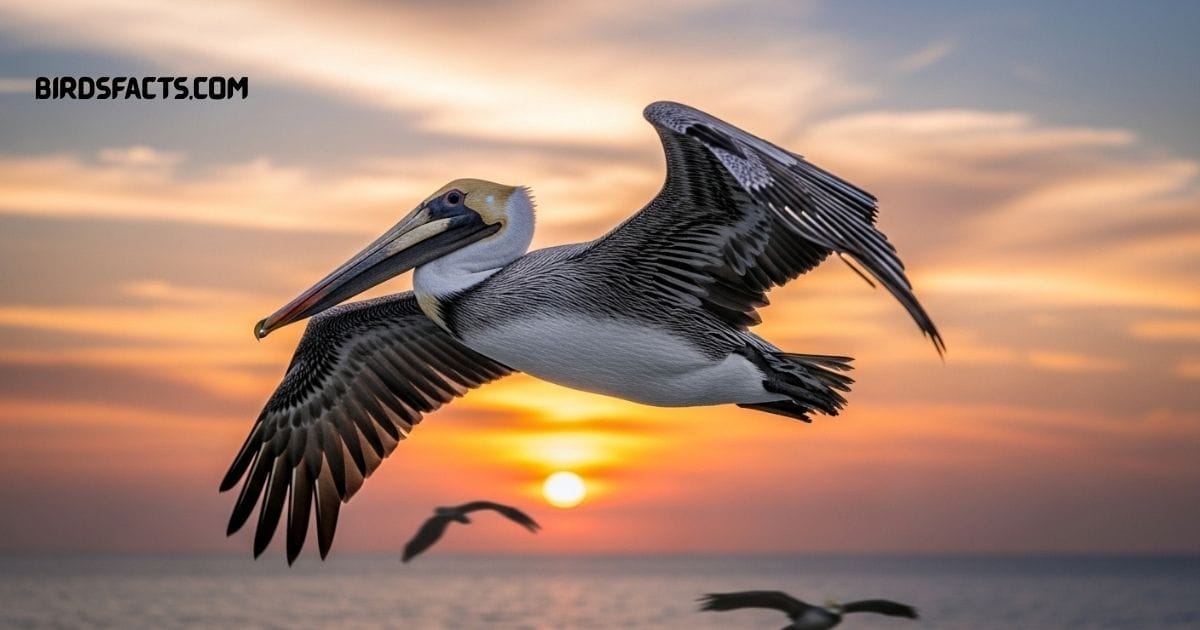
Brown Pelican With Long Pouch Beak And Brown-gray Feathers Gliding Over Coastal Waters
The Brown Pelican Is A Familiar Sight Along Florida’s Coastline Skimming Just Above The Waves Before Plunging Headfirst Into The Water To Catch Fish. Its Long Pouched Bill Is Perfectly Adapted For Scooping Up Prey And Draining Seawater Before Swallowing. Breeding Adults Display Striking Plumage With Bright Yellow Heads And Chestnut Necks Making Them One Of The Most Distinctive Florida Birds With Long Beaks Seen Year Round Along The Coast.
Seabirds Such As The Brown Pelican Thrive In Coastal Habitats Like Estuaries Piers And Ocean Waters. Once Considered Endangered Because Of Pesticide Use These Birds Have Successfully Rebounded Becoming A True Conservation Success Story. Watching Them Dive Gracefully Into The Surf Is A Perfect Example Of The Beauty Found Among Florida Birds With Long Beaks That Define The State’s Shorelines.
| Fact | Detail |
|---|---|
| Range | Found Along The Coasts Of North South And Central America Including The Gulf Of Mexico And The Caribbean |
| Key Fact | Only Pelican Species That Dives Headfirst Into Water To Catch Fish |
| Plumage | Brownish Gray Body With White Head And Yellow Wash During Breeding Season |
| Behavior | Graceful Diver Often Seen Gliding Over Waves In V Shaped Formations |
| Diet | Feeds Mainly On Fish Caught By Plunging Into The Water From Heights Up To Sixty Feet |
Black-Bellied Plover

Black-necked Stilt With Long Thin Legs, Slender Black Beak, And Black-and-white Body Wading In Shallow Water
Although Not As Long Billed As Some Species The Black Bellied Plover Has A Sturdy Pointed Beak Ideal For Probing Mudflats For Marine Worms Crustaceans And Insects. In Breeding Plumage Males Display Bold Black Underparts And A Striking White And Black Patterned Back While In The Non Breeding Season Their Coloration Becomes More Muted Making Them One Of The More Subtle Florida Birds With Long Beaks Seen Along The Shoreline.
These Migratory Birds Travel Impressive Distances Breeding In The Arctic And Wintering Along Florida’s Coasts. You’re Most Likely To Spot Them On Tidal Flats And Sandy Beaches During Migration Where They Feed Continuously To Build Energy For Their Long Flights A True Example Of Endurance Among Florida Birds With Long Beaks That Connect Distant Worlds Through Migration.
| Fact | Detail |
|---|---|
| Range | Found Along The Coasts Of North And South America Breeding In The Arctic Tundra |
| Key Fact | Largest Plover In North America Known For Its Distinct Black Belly During Breeding Season |
| Plumage | Breeding Plumage Features Black Face And Belly With White Crown And Back Nonbreeding Birds Are Gray |
| Behavior | Often Seen Along Mudflats And Beaches Standing Alert And Probing For Food |
| Diet | Feeds On Insects Worms Crustaceans And Small Mollusks |
Black-Necked Stilt

Black-necked Stilt With Long Thin Legs, Slender Black Beak, And Black-and-white Body Wading In Shallow Water
The Black Necked Stilt Is A Graceful Wading Bird Recognized By Its Long Pink Legs And Contrasting Black And White Plumage. Its Thin Straight Bill Is Perfectly Shaped For Picking Tiny Aquatic Prey From Shallow Waters Making It One Of The Most Distinctive Florida Birds With Long Beaks Seen In Wetlands Across The State. Its Elegant High Stepping Walk And Sharp Profile Make It A Favorite Among Bird Photographers.
They Inhabit Marshes Wetlands And Coastal Flats Often Forming Small Flocks That Move In Perfect Coordination. During The Breeding Season These Birds Become Highly Protective Of Their Nests Near The Water’s Edge. Their Sharp Alarm Calls Can Be Heard Echoing Across The Marshes A Signature Sound Among Florida Birds With Long Beaks That Bring Life And Beauty To The State’s Waterways.
| Fact | Detail |
|---|---|
| Range | Found Throughout The Americas From The Western And Southern United States To Central And South America |
| Key Fact | Graceful Wading Bird Recognized By Its Striking Black And White Plumage And Exceptionally Long Pink Legs |
| Plumage | Black Upperparts White Underparts And Red Eyes With Long Thin Black Bill |
| Behavior | Often Seen Wading In Shallow Water Or Nesting In Colonies Near Wetlands |
| Diet | Feeds On Insects Crustaceans Mollusks And Small Fish Picked From The Water Surface |
Black Skimmer

Black Skimmer With Black Upper Body, White Underside, And Long Orange Beak Flying Low Over Water
The Black Skimmer Has One Of The Most Fascinating Beaks Among Florida Birds With Long Beaks Its Lower Mandible Is Longer Than The Upper Allowing It To Skim The Water’s Surface In Flight To Catch Small Fish. This Unique Adaptation Fits Perfectly With Its Coastal Lifestyle Where Calm Bays And Sandy Shores Offer Ideal Feeding Conditions.
In Florida Black Skimmers Nest In Colonies On Beaches And Sandbars Their Black Upperparts And White Underparts Form A Sharp Contrast While The Bright Orange Bill Adds A Touch Of Color To The Shoreline. As One Of The Most Distinctive Florida Birds With Long Beaks They Are Also A Species Of Concern Due To Habitat Loss And Human Activity Making Conservation Efforts Essential To Protect Their Future.
| Fact | Detail |
|---|---|
| Range | Found Along The Atlantic Gulf And Pacific Coasts Of The Americas Including The Caribbean |
| Key Fact | Unique Seabird With A Lower Bill Longer Than The Upper Used To Skim The Water Surface For Fish |
| Plumage | Black Upperparts White Underside Orange Red Bill With Black Tip And Red Legs |
| Behavior | Often Seen Flying Low Over Water With Lower Bill Cutting The Surface To Catch Fish |
| Diet | Feeds Mainly On Small Fish And Crustaceans |
Belted Kingfisher

Belted Kingfisher with shaggy crest, blue-gray plumage, and long pointed beak perched near water
With Its Shaggy Crest Stocky Body And Long Pointed Bill The Belted Kingfisher Is Built For Catching Fish. Perched Over Rivers Lakes And Coastal Lagoons It Dives Headfirst Into The Water Stunning And Swallowing Its Prey Whole. Males And Females Look Similar Though Females Show An Extra Rusty Band Across The Chest Making This One Of The Most Striking Florida Birds With Long Beaks Seen Near Water.
These Birds Are Year Round Residents And Often Announce Their Presence With Loud Rattling Calls Long Before They’re Visible. Like Many Florida Birds With Long Beaks They Favor Open Water With Convenient Perches Such As Branches Or Docks From Which They Can Watch Patiently For Their Next Catch.
| Fact | Detail |
|---|---|
| Range | Found Throughout North America Near Rivers Lakes Ponds And Coastal Waters |
| Key Fact | Easily Recognized By Its Loud Rattling Call And Crest Of Feathers On The Head |
| Plumage | Blue Gray Upperparts White Underside And Broad Blue Breast Band Females Have An Additional Rusty Band |
| Behavior | Perches Near Water Before Diving Headfirst To Catch Fish With Its Strong Bill |
| Diet | Feeds Mainly On Fish But Also Eats Crustaceans Amphibians And Insects |
Cattle Egret

Cattle Egret With White Feathers, Short Yellow Beak, And Orange Breeding Plumes Standing In Grassland
| Fact | Detail |
|---|---|
| Range | Found On Every Continent Except Antarctica Often Near Grasslands Farmlands And Wetlands |
| Key Fact | Frequently Seen Following Cattle Or Other Large Animals To Catch Insects They Stir Up |
| Plumage | White Body With Buff Orange Plumes On Head Chest And Back During Breeding Season |
| Behavior | Social Bird That Often Feeds In Flocks And Nests In Colonies With Other Waterbirds |
| Diet | Feeds On Insects Frogs And Small Vertebrates Often Captured In Grassy Fields |
Florida Sandhill Crane
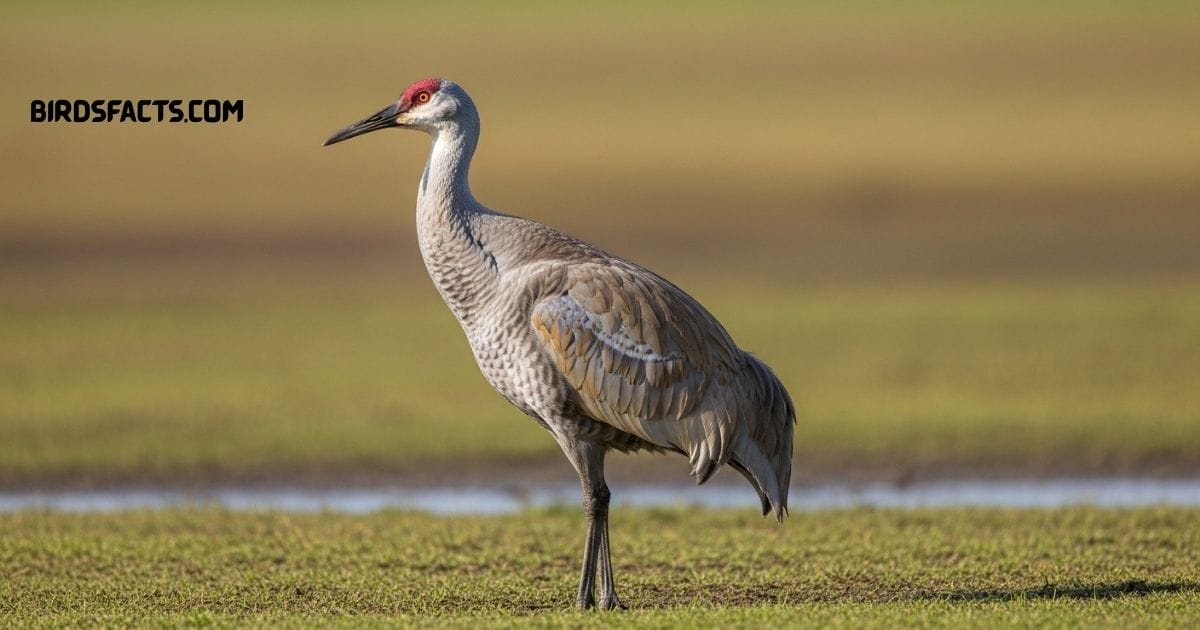
Florida Sandhill Crane with long legs, gray feathers, and red crown foraging in wetlands
The Florida Sandhill Crane Is A Tall Graceful Member Of The Florida Birds With Long Beaks Recognized By Its Bright Red Forehead And Long Pointed Bill. This Non Migratory Subspecies Is Unique To The State Inhabiting Freshwater Marshes Prairies And Wetlands Where It Feeds On Plants Insects And Small Animals.
Known For Their Courtship Dances And Resonant Bugling Calls These Cranes Are Among The Most Beloved Florida Birds With Long Beaks In The Region. Their Declining Numbers Due To Habitat Loss Make Wetland Protection Essential To Preserve These Majestic Symbols Of Florida’s Natural Beauty.
| Fact | Detail |
|---|---|
| Range | Found Year Round In Central And South Florida Preferring Wet Prairies Marshes And Open Fields |
| Key Fact | Non Migratory Subspecies Of The Sandhill Crane Known For Its Loud Trumpeting Call And Graceful Movements |
| Plumage | Gray Body Often Stained Reddish Brown With Bright Red Forehead And White Cheeks |
| Behavior | Often Seen In Pairs Or Small Family Groups Performing Courtship Dances And Loud Duet Calls |
| Diet | Feeds On Grains Seeds Insects Frogs And Small Vertebrates |
Greater Flamingo

Greater Flamingo With Pale Pink Feathers, Long Neck, And Downward Curved Beak Wading In Shallow Water
| Fact | Detail |
|---|---|
| Range | Found In Africa Southern Europe The Middle East And Parts Of South And Asia |
| Key Fact | Tallest And Most Widespread Flamingo Species Known For Its Graceful Stance And Pale Pink Color |
| Plumage | Pale Pink Body With Deep Pink Wing Coverts And Black Flight Feathers |
| Behavior | Highly Social Bird That Lives In Large Colonies Often Seen Wading In Shallow Saline Lakes |
| Diet | Feeds On Small Crustaceans Algae And Plankton Filtered Through Its Specialized Bill |
Great Egret

Great Egret With Long White Feathers, Slender Neck, And Sharp Yellow Beak Standing Gracefully In Wetlands
The Great Egret Is One Of The Most Iconic Florida Birds With Long Beaks Recognized By Its Pure White Plumage Long Black Legs And Sharp Yellow Bill. Its Dagger Like Beak Is Perfect For Spearing Fish Frogs And Other Aquatic Creatures Making It A Skilled Hunter In Shallow Waters. During Breeding Season It Displays Elegant Lacy Feathers Along Its Back Adding To Its Majestic Look.
Common Across Wetlands Marshes And Coastal Regions The Great Egret Stands As A Symbol Of Grace Among Florida Birds With Long Beaks. It Often Waits Motionless Before Striking With Lightning Speed. Once Threatened By The Plumage Trade This Species Has Recovered Strongly Through Ongoing Conservation Efforts.
| Fact | Detail |
|---|---|
| Range | Found Worldwide In Temperate And Tropical Regions Near Marshes Lakes Rivers And Coastal Areas |
| Key Fact | Large Elegant Wading Bird Known For Its Long S Curved Neck And Striking White Plumage |
| Plumage | Pure White Feathers With Long Black Legs And Yellow Bill That Turns Dark During Breeding Season |
| Behavior | Moves Gracefully Through Shallow Water Spearing Fish With Quick Precise Strikes |
| Diet | Feeds On Fish Frogs Small Mammals And Aquatic Insects |
Grey-Headed Swamphen

Grey-headed Swamphen With Grey Head, Bright Purple-blue Body, And Red Beak Walking Near Wetlands
Originally From Southern Asia The Grey Headed Swamphen Has Become One Of The Most Distinctive Florida Birds With Long Beaks. With Its Deep Blue And Purple Plumage Red Facial Shield And Stout Red Bill It Adds A Touch Of Exotic Beauty To The State’s Wetlands. Though It Primarily Feeds On Plant Material Its Bill Is Strong Enough To Strip Leaves And Stems With Ease.
Now A Naturalized Resident Of Florida’s Freshwater Marshes This Species Thrives Among Dense Vegetation Where It Builds Nests Just Above The Waterline. Bold And Vocal The Grey Headed Swamphen Stands Out As A Vibrant Example Of Adaptation Among Florida Birds With Long Beaks.
| Fact | Detail |
|---|---|
| Range | Found In The Middle East The Indian Subcontinent Southern China Northern Thailand And Introduced Populations In Florida |
| Key Fact | Large Marsh Bird With Grey Head And Bright Purple Blue Body Split From The Purple Swamphen Species Group |
| Plumage | Grey Head And Neck With Deep Purple Blue Body Red Bill And Frontal Shield And Long Red Legs |
| Behavior | Walks Gracefully On Floating Vegetation Uses Long Toes For Balance And Builds Nests In Reeds |
| Diet | Feeds On Aquatic Plants Shoots Bulbs Insects Snails And Small Fish |
Great Blue Heron
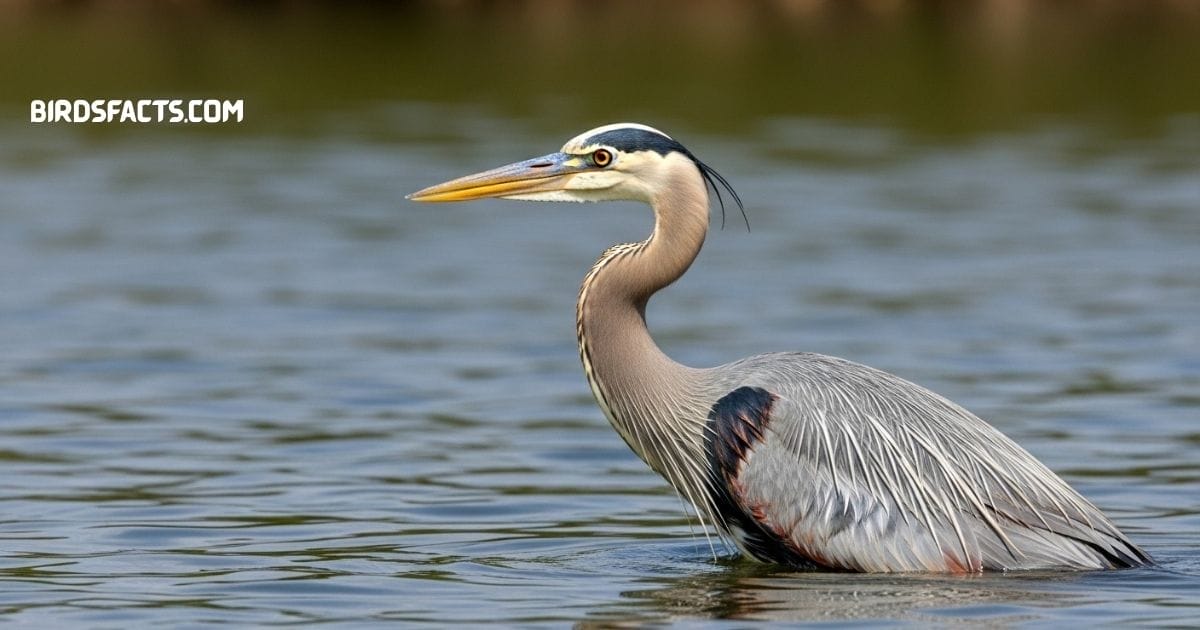
Great Blue Heron With Long Neck, Sharp Yellow Beak, And Blue-gray Feathers Standing In Shallow Water
The Great Blue Heron Is One Of The Most Impressive Florida Birds With Long Beaks Standing As The Largest Heron In North America. With Its Slate Gray Body Long Legs And Sharp Yellowish Bill It Uses Its Powerful Beak To Catch Fish Amphibians And Even Small Mammals. This Patient Hunter Moves Slowly Through Shallow Waters Before Striking With Lightning Speed.
A Common Year Round Resident Across Wetlands Estuaries And Coastal Lagoons The Great Blue Heron Embodies The Grace And Strength Seen In Many Florida Birds With Long Beaks. Despite Its Size It Flies With Remarkable Elegance Using Deep Wingbeats And A Tucked In Neck That Make It Instantly Recognizable In The Florida Sky.
| Fact | Detail |
|---|---|
| Range | Found Throughout North America From Alaska And Canada To The Caribbean And Northern South America |
| Key Fact | Largest North American Heron Known For Its Graceful Flight Long Legs And S Shaped Neck |
| Plumage | Blue Gray Body With White Face Black Plumes Above The Eyes And Long Yellow Bill |
| Behavior | Solitary Wader Often Seen Standing Motionless In Shallow Water Waiting To Spear Fish |
| Diet | Feeds On Fish Frogs Small Mammals Reptiles And Insects |
King Rail
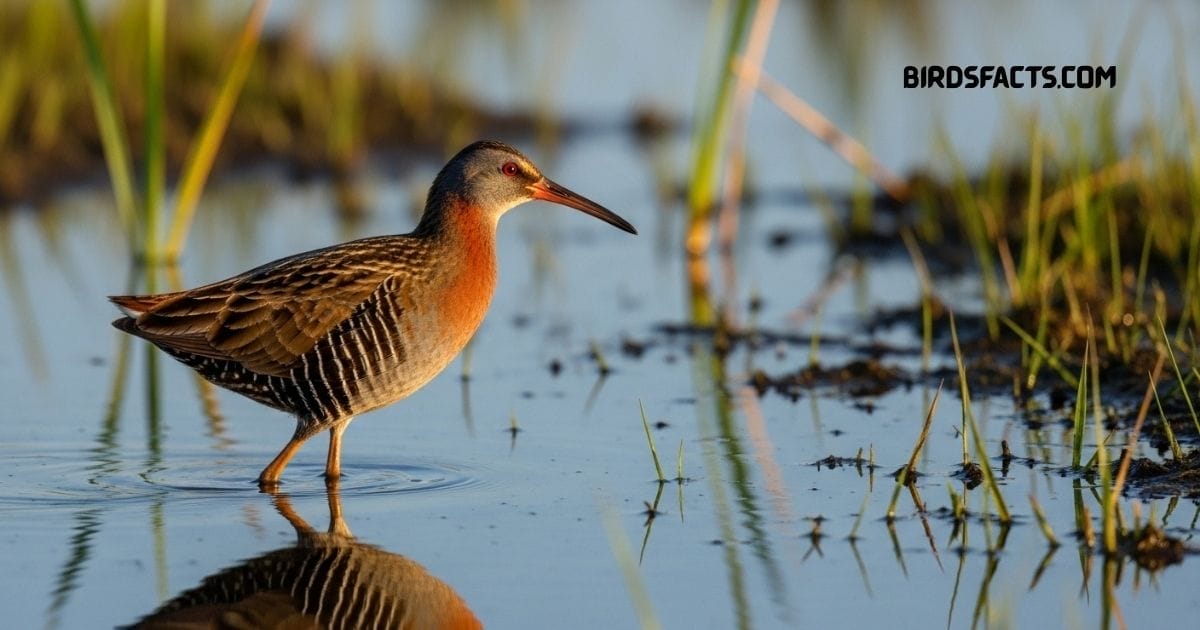
King Rail With Long Slightly Curved Beak, Brown Streaked Plumage, And Long Legs Walking In Marsh Grass
| Fact | Detail |
|---|---|
| Range | Found In Eastern North America From The Great Lakes Region To The Gulf Coast And Mexico |
| Key Fact | Largest North American Rail Known For Its Loud Kek Kek Kek Calls In Marsh Habitats |
| Plumage | Rusty Brown Body With Gray Face Buff Underparts And Long Slightly Curved Bill |
| Behavior | Secretive And Shy Prefers Dense Marsh Vegetation And Often Seen Walking Rather Than Flying |
| Diet | Feeds On Crustaceans Insects Small Fish And Aquatic Plants |
Long-Billed Dowitcher

Long-billed Dowitcher With Mottled Brown Plumage And Very Long Straight Beak Probing Mudflats For Food
The Long Billed Dowitcher Is One Of The Most Fascinating Florida Birds With Long Beaks Recognized By Its Exceptionally Long Bill That Moves Like A Sewing Machine Needle As It Probes Rapidly Into Mudflats For Invertebrates. During Breeding Season It Displays Rich Reddish Brown Plumage While In Winter It Turns Gray Making It Harder To Spot Among Coastal Habitats.
These Migratory Birds Pass Through Florida During Spring And Fall Stopping At Wetlands Tidal Flats And Estuaries To Feed And Rest. Their Distinctive Foraging Motion Makes Them Easy To Identify Among Other Florida Birds With Long Beaks A True Reward For Birdwatchers Who Know Where To Look.
| Fact | Detail |
|---|---|
| Range | Found Across North America Breeding In Northern Canada And Alaska And Migrating To The Southern United States Central America And Northern South America |
| Key Fact | Medium Sized Shorebird Recognized By Its Long Straight Bill Used For Probing Deep Into Mudflats |
| Plumage | Breeding Plumage Features Reddish Underside With Brown Upperparts While Nonbreeding Birds Are Gray |
| Behavior | Often Seen In Shallow Wetlands Rapidly Probing For Food In A Sewing Machine Like Motion |
| Diet | Feeds On Insects Worms Crustaceans And Mollusks Found In Mud And Shallow Water |
Little Blue Heron
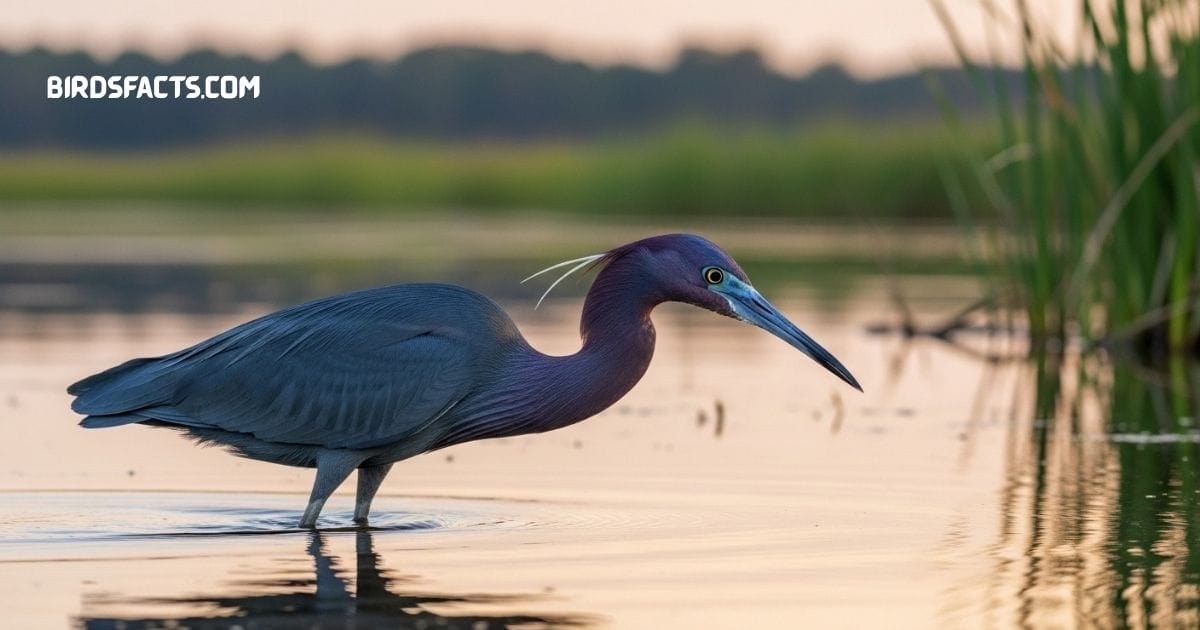
Little Blue Heron With Slender Dark Blue Body, Long Neck, And Pointed Beak Wading In Shallow Water
The Little Blue Heron Is One Of The Most Elegant Florida Birds With Long Beaks Recognized By Its Slate Blue Body And Long Slender Bill Tipped In Black. Juveniles Are Entirely White Which Helps Them Blend With Snowy Egrets Reducing Aggression From Other Species. This Bird Feeds Patiently On Fish Amphibians And Insects Moving Gracefully Through Shallow Waters.
Found Throughout Wetlands And Coastal Lagoons Across The State These Florida Birds With Long Beaks Are Masters Of Stealth And Precision. Though Smaller Than The Great Blue Heron Their Calm Poise And Quiet Hunting Style Make Them A Favorite Among Birdwatchers Seeking Florida’s Subtle Marshland Beauty.
| Fact | Detail |
|---|---|
| Range | Found Throughout The Southeastern United States Central America The Caribbean And Northern South America |
| Key Fact | Medium Sized Heron Known For Its Slate Blue Plumage And Graceful Foraging Style In Shallow Waters |
| Plumage | Adults Are Slate Blue While Juveniles Are Pure White Gradually Turning Blue As They Mature |
| Behavior | Moves Slowly And Deliberately Through Marshes And Shorelines Stalking Fish And Insects |
| Diet | Feeds On Fish Frogs Crustaceans Insects And Small Reptiles |
Limpkin

Limpkin With Long Slightly Curved Beak, Brown Body With White Streaks, Walking Near Freshwater Wetlands
The Limpkin Is One Of The Most Distinctive Florida Birds With Long Beaks Recognized By Its Slightly Curved Bill And Mournful Wailing Call That Echoes Across Wetlands At Night. Its Bill Is Specially Adapted For Feeding On Apple Snails Which It Extracts With Remarkable Precision. While It Occasionally Eats Other Mollusks Apple Snails Remain Its Main Source Of Food.
Found In Freshwater Marshes Swamps And Along Slow Moving Rivers These Florida Birds With Long Beaks Blend Seamlessly Into Their Surroundings Thanks To Their Brown Streaked Plumage. Though They Resemble Herons They Belong To Their Own Unique Bird Family Making The Limpkin A True Florida Original.
| Fact | Detail |
|---|---|
| Range | Found In The Southeastern United States Central America The Caribbean And Parts Of South America |
| Key Fact | Unique Wading Bird Recognized By Its Loud Wailing Cry And Preference For Feeding On Apple Snails |
| Plumage | Brown Body With White Streaks On Head Neck And Wings Giving A Speckled Appearance |
| Behavior | Slow Moving And Solitary Often Seen Wading In Shallow Water Or Perched Along Marsh Edges |
| Diet | Feeds Mainly On Apple Snails But Also Eats Mussels Insects Frogs And Crustaceans |
Long-Billed Curlew

Long-billed Curlew With Very Long Downward Curved Beak, Mottled Brown Plumage, And Long Legs In Grassland
The Long Billed Curlew Is One Of The Most Extraordinary Florida Birds With Long Beaks Famous For Having The Longest Bill Of Any Shorebird In North America. This Dramatically Downcurved Beak Can Reach Up To Eight Inches Allowing The Bird To Probe Deep Into Mudflats For Marine Worms Crustaceans And Insects That Other Species Cannot Access. In Breeding Plumage Its Warm Buff Tones And Speckled Back Provide Excellent Camouflage In Open Grasslands.
While Its Primary Breeding Range Lies Far From Florida These Florida Birds With Long Beaks Occasionally Visit Coastal Habitats During Winter. Sightings Typically Occur On Tidal Flats Or Sandy Beaches Where They Methodically Use Their Remarkable Bills To Search For Hidden Prey Beneath The Surface A True Wonder For Any Birdwatcher Lucky Enough To Spot One.
| Fact | Detail |
|---|---|
| Range | Found Across Western North America Breeding In Grasslands And Migrating To Coastal Areas For Winter |
| Key Fact | Largest North American Shorebird Recognized By Its Exceptionally Long Downcurved Bill |
| Plumage | Warm Cinnamon Brown Body With Light And Dark Patterned Feathers And Long Legs |
| Behavior | Feeds By Probing Deep Into Mud And Sand For Crabs Worms And Other Invertebrates |
| Diet | Feeds On Crustaceans Insects Worms And Occasionally Small Fish |
Masked Booby

Masked Booby With White Body, Black-tipped Wings, And Yellow Beak Featuring A Dark Facial Mask Perched By The Sea
The Masked Booby Is One Of The Most Impressive Florida Birds With Long Beaks Distinguished By Its Bright White Body Black Wingtips And Long Pointed Yellow Bill. This Powerful Seabird Dives From Great Heights Into Open Ocean Waters To Catch Fish And Squid Displaying Precision And Strength In Every Plunge.
Though Rare Around The Mainland These Florida Birds With Long Beaks Are Occasionally Spotted In The Dry Tortugas Or Far Offshore Areas. Their Love For Remote Islands And Solitary Nesting Habits Makes Every Sighting A Special Event For Birdwatchers Exploring Florida’s Tropical Waters.
| Fact | Detail |
|---|---|
| Range | Found In Tropical Oceans Worldwide Including The Caribbean Pacific And Indian Oceans |
| Key Fact | Largest Of The Booby Species Recognized By Its White Body Black Mask And Black Wing Tips |
| Plumage | White Body With Black Flight Feathers And Tail And Distinct Black Mask Around The Eyes |
| Behavior | Strong Diver That Plunges From Great Heights Into The Ocean To Catch Fish And Squid |
| Diet | Feeds Mainly On Fish And Squid Caught By Aerial Diving |
Royal Tern

Royal Tern With Sleek White Body, Black Crest, And Long Orange Beak Standing Along The Shoreline
The Royal Tern Is A Sleek Seabird With A Bright Orange Bill A Black Crest In Breeding Season And Long Narrow Wings Designed For Fast Graceful Flight. It Feeds Mainly On Fish Which It Catches By Diving Headfirst Into The Water From Midair. These Terns Are Common Along Florida’s Sandy Beaches Barrier Islands And Estuaries. They Often Gather In Noisy Flocks Mixing With Gulls And Other Shorebirds. Their Bold Coloring And Sharp Calls Make Them A Lively Part Of Florida’s Coastal Birdlife.
As One Of The Most Distinctive Florida Birds With Long Beaks The Royal Tern Represents Both Beauty And Function In Coastal Ecosystems. Its Streamlined Bill And Agile Flight Allow It To Thrive In Windy Shores And Open Bays Where Few Birds Hunt So Efficiently. Watching These Florida Birds With Long Beaks Hover And Dive In Synchrony Is A True Highlight For Anyone Exploring The Sunshine State’s Shorelines.
| Fact | Detail |
|---|---|
| Range | Found Along The Atlantic And Gulf Coasts Of North America The Caribbean And The Atlantic Coast Of Africa |
| Key Fact | Elegant Seabird Recognized By Its Orange Bill And Distinctive Black Crest During Breeding Season |
| Plumage | Pale Gray Upperparts White Underside And Black Crest With Long Forked Tail |
| Behavior | Often Seen Flying Gracefully Over The Ocean Diving To Catch Fish And Nesting In Large Colonies |
| Diet | Feeds Mainly On Small Fish And Occasionally Crustaceans Caught By Diving Into The Water |
Reddish Egret
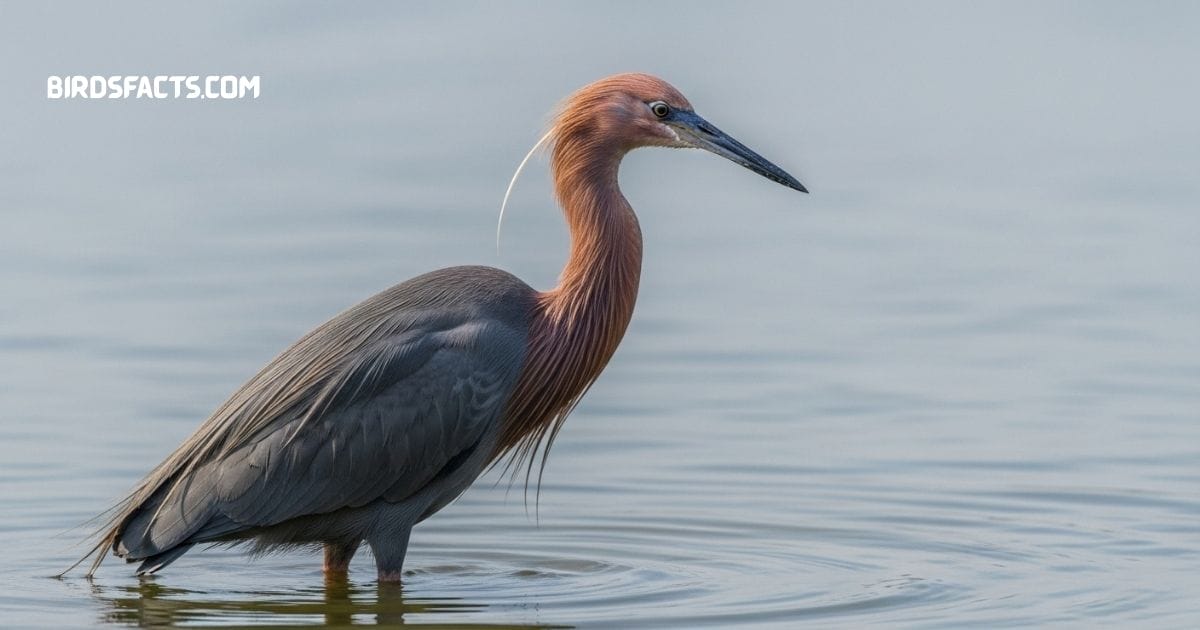
Reddish Egret With Shaggy Reddish Feathers, Slender Gray Body, And Pointed Beak Hunting In Shallow Water
| Fact | Detail |
|---|---|
| Range | Found Along The Gulf Coast Caribbean Mexico And Central America In Shallow Coastal Lagoons And Salt Flats |
| Key Fact | Energetic Hunter Known For Its Unique Dancing Feeding Style As It Chases Fish In Shallow Water |
| Plumage | Comes In Two Color Forms A Dark Morph With Slate Blue Body And Reddish Head And A White Morph With All White Plumage |
| Behavior | Active And Graceful Wader Often Seen Running Jumping And Spreading Wings To Startle Prey |
| Diet | Feeds Mainly On Small Fish But Also Eats Crustaceans And Aquatic Insects |
Snowy Egret
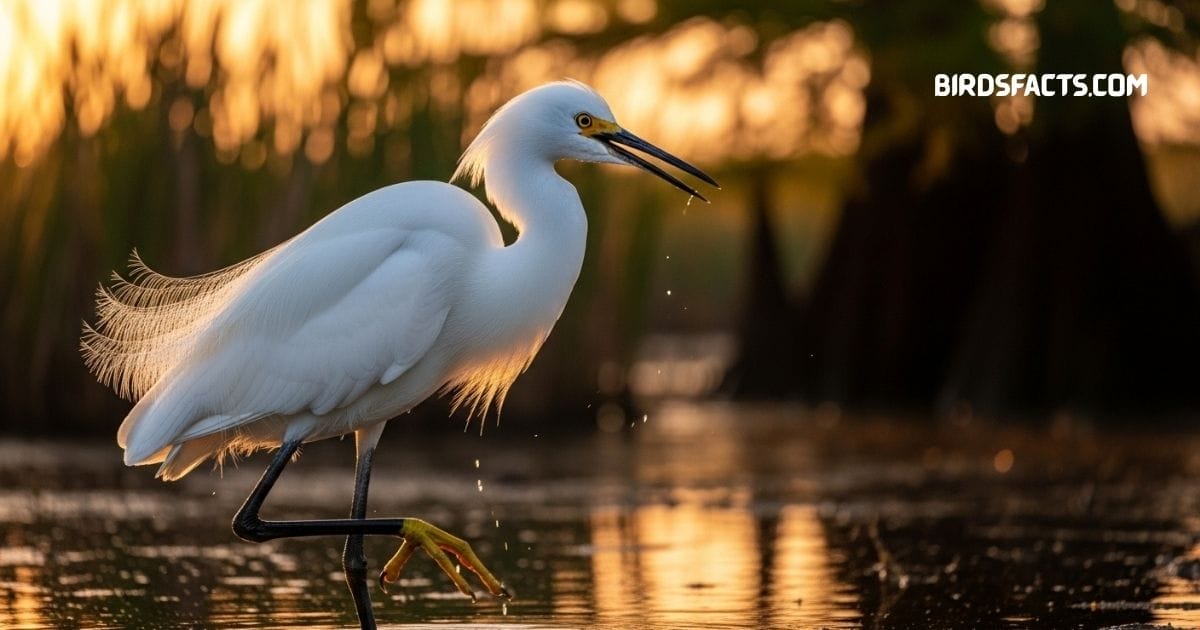
Snowy Egret With Slender Black Beak, White Plumage, And Yellow Feet Standing In Shallow Wetlands
The Snowy Egret Is A Small Elegant Wading Bird With Pure White Plumage Slender Black Legs And Bright Yellow Feet. Its Long Thin Black Bill Is Ideal For Catching Fish Amphibians And Insects In Shallow Waters. During Breeding Season It Develops Delicate Lacy Plumes That Were Once Prized In The Feather Trade.
Among Florida Birds With Long Beaks The Snowy Egret Is Known For Its Graceful Hunting Style Often Darting And Stirring The Water With Its Feet To Flush Prey. These Florida Birds With Long Beaks Are Common In Wetlands Estuaries And Coastal Lagoons Where Their Quick Reflexes And Bright Yellow Feet Make Them Both Effective Hunters And Stunning Sights For Birdwatchers.
| Fact | Detail |
|---|---|
| Range | Found Throughout The Americas From The United States To South America In Wetlands Marshes And Coastal Areas |
| Key Fact | Elegant Small Egret Known For Its Striking White Plumage And Bright Yellow Feet Used To Stir Up Fish |
| Plumage | Pure White Feathers With Black Legs Yellow Feet And Black Bill With Yellow At The Base |
| Behavior | Active Feeder That Darts Gracefully Through Shallow Water Often Stirring Prey With Its Feet |
| Diet | Feeds On Fish Crustaceans Insects And Amphibians |
Sanderling
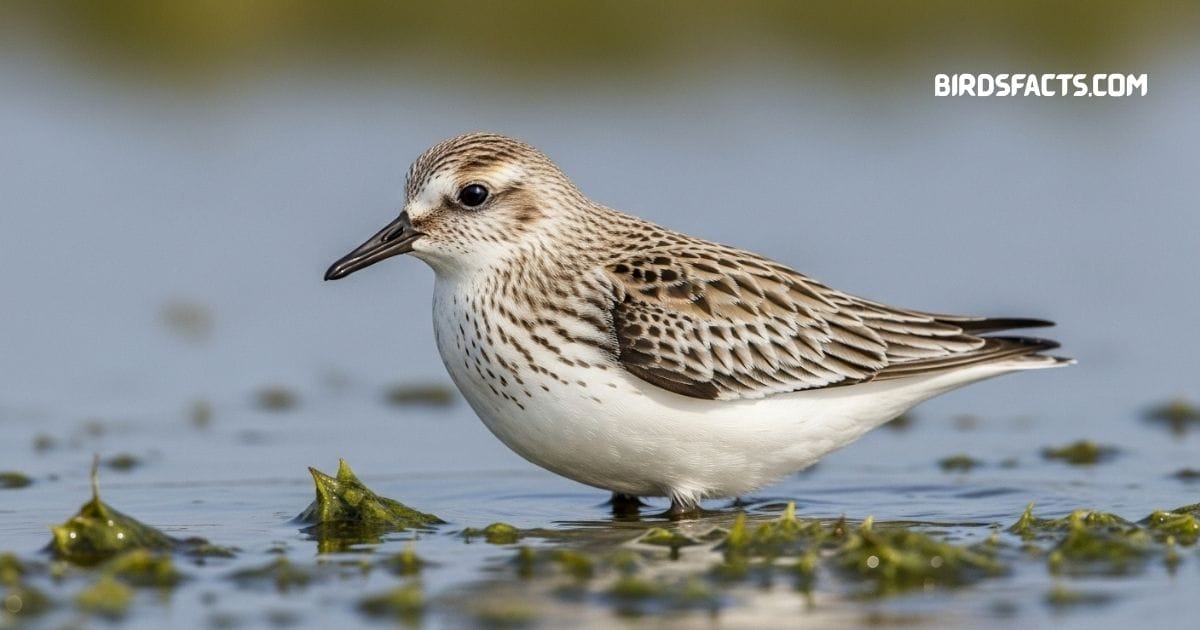
Sanderling With Pale Gray Plumage, Short Black Beak, And Quick Legs Running Along Sandy Shoreline
Snail Kite
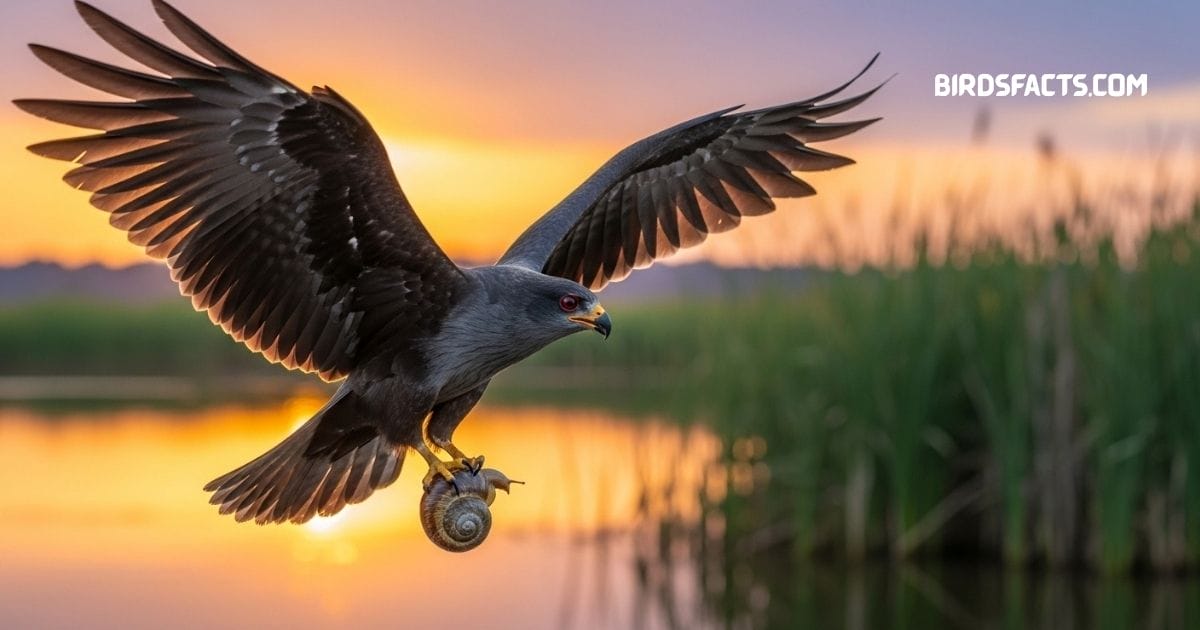
Snail Kite With Dark Plumage, Hooked Beak, And Broad Wings Soaring Over Freshwater Wetlands
The Snail Kite Is A Specialized Raptor With A Sharply Hooked Beak Adapted For Extracting Apple Snails From Their Shells. Males Are Slate Gray With White Rumps While Females Are Brown With Streaked Underparts. This Species Is Highly Dependent On Wetland Habitats Rich In Apple Snails.
Among Florida Birds With Long Beaks The Snail Kite Stands Out For Its Precision Feeding Style And Narrow Ecological Niche. Found Mainly In Central And Southern Wetlands These Florida Birds With Long Beaks Are Considered Endangered Due To Habitat Loss And Declining Snail Populations. Ongoing Conservation Efforts Aim To Protect Their Habitats And Ensure This Unique Raptor Continues To Grace Florida’s Skies.
| Fact | Detail |
|---|---|
| Range | Found In Florida Central America The Caribbean And Parts Of South America In Freshwater Marshes And Lakes |
| Key Fact | Specialized Raptor That Feeds Almost Exclusively On Apple Snails Using Its Sharp Hooked Bill To Extract Them From Shells |
| Plumage | Males Are Slate Gray With Red Eyes And Legs While Females Are Brown With Streaked Undersides |
| Behavior | Graceful Flier That Glides Low Over Water Searching For Snails Often Perching On Reeds Or Trees Near Marshes |
| Diet | Feeds Mainly On Apple Snails And Occasionally Other Aquatic Invertebrates |
Tricolored Heron

Ricolored Heron With Blue-gray Wings, White Belly, And Long Pointed Beak Wading In Shallow Water
The Tricolored Heron Is A Slender Medium Sized Wader With A Long Pointed Bill And A Mix Of Blue Gray White And Reddish Plumage. It Feeds Mainly On Fish And Small Aquatic Creatures Using A Slow Deliberate Stalking Technique In Shallow Waters.
Among Florida Birds With Long Beaks The Tricolored Heron Is One Of The Most Graceful Hunters Often Seen In Coastal Marshes Estuaries And Lagoons. During Breeding Season These Florida Birds With Long Beaks Display Wispy Plumes And Brighter Facial Colors Creating A Truly Striking Sight For Birdwatchers Exploring The Sunshine State.
| Fact | Detail |
|---|---|
| Range | Found In The Southeastern United States Central America The Caribbean And Northern South America |
| Key Fact | Graceful Wading Bird Recognized By Its Slender Neck And Mix Of Blue Gray White And Reddish Feathers |
| Plumage | Blue Gray Upperparts White Underside And Reddish Neck With Yellow Legs And Bill |
| Behavior | Active Feeder That Stalks And Dashes Through Shallow Water To Catch Fish And Small Aquatic Prey |
| Diet | Feeds On Fish Frogs Crustaceans And Insects |
Whooping Crane
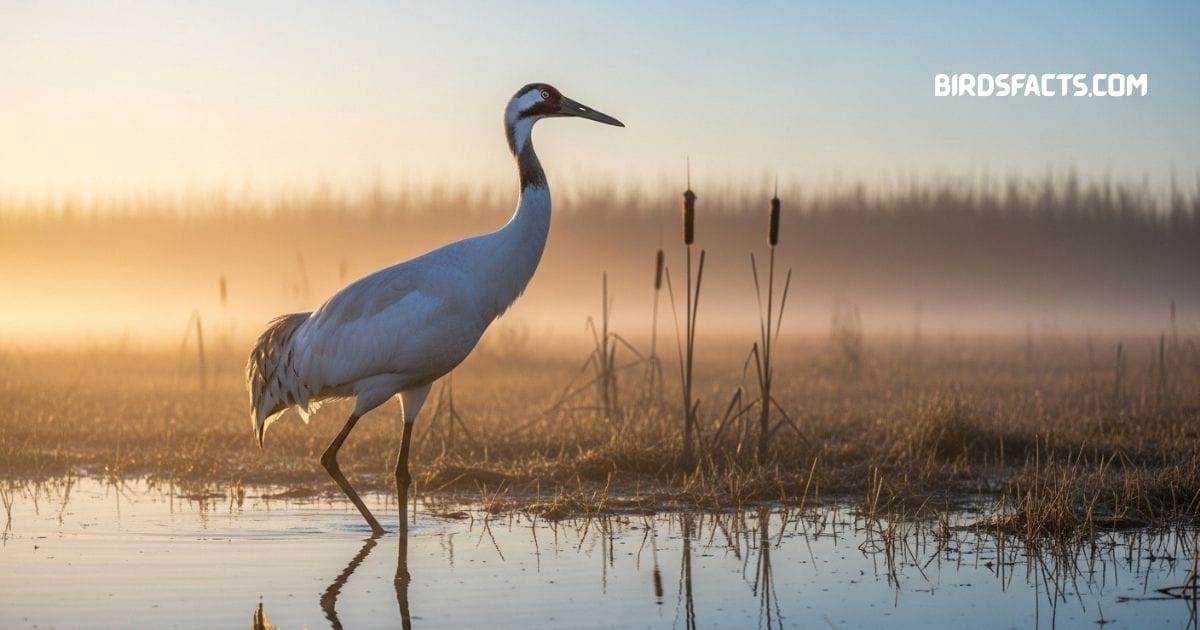
Whooping Crane With Tall White Body, Long Slender Neck, Red Crown, And Pointed Beak Standing In Marshland
The Whooping Crane Is One Of North America’s Rarest Birds With Fewer Than One Thousand Individuals Remaining. Standing Nearly Five Feet Tall It Has A Long Straight Bill Perfect For Catching A Variety Of Prey From Insects And Crustaceans To Plant Roots. Its Pure White Plumage Contrasts Sharply With Black Wingtips Visible In Flight.
Among Florida Birds With Long Beaks The Whooping Crane Stands As A Symbol Of Conservation And Hope. Although Not Native To The State A Small Non Migratory Population Was Introduced In Florida’s Marshes And Prairies Where These Florida Birds With Long Beaks Use Their Powerful Calls To Communicate Across Vast Distances. Seeing One In The Wild Is A Rare And Inspiring Experience.
| Fact | Detail |
|---|---|
| Range | Found In North America Breeding In Canada And Wintering Along The Gulf Coast Of Texas |
| Key Fact | Tallest Bird In North America And One Of The Rarest With An Inspiring Conservation Comeback Story |
| Plumage | Pure White Body With Black Wingtips And Red Crown |
| Behavior | Graceful Wader Known For Its Loud Trumpeting Calls And Elegant Courtship Dances |
| Diet | Feeds On Crustaceans Fish Insects And Aquatic Plants |
Wood Stork

Wood Stork With Large Curved Beak, White Body, And Dark Feathered Wings Standing In Wetlands
The Wood Stork Is A Large Wading Bird With A Bald Head Long Legs And A Thick Downcurved Bill Used To Snap Up Fish And Other Aquatic Prey. It Hunts By Touch Moving Slowly Through Shallow Waters With Its Bill Partially Open And Snapping Shut Instantly When It Detects Movement.
Among Florida Birds With Long Beaks The Wood Stork Is One Of The Most Distinctive Species Recognized By Its Size And Ancient Appearance. Though Once Endangered Its Population Has Gradually Recovered Thanks To Conservation Efforts. These Florida Birds With Long Beaks Nest In Large Colonies Within Cypress Swamps And Rely On Stable Wetland Conditions To Thrive Making Them A True Indicator Of Ecosystem Health.
| Fact | Detail |
|---|---|
| Range | Found In The Southeastern United States Central America And South America In Swamps Marshes And Wetlands |
| Key Fact | Only Stork Species That Breeds In North America Recognized By Its Bald Head And Long Downcurved Bill |
| Plumage | White Body With Black Flight Feathers And Bare Dark Gray Head And Neck |
| Behavior | Wades Slowly Through Shallow Water Feeding By Touch Using Its Bill To Snap Shut On Fish |
| Diet | Feeds On Fish Frogs Insects And Crustaceans |
White Ibis

White Ibis With White Body Long Curved Orange Beak And Pink Legs Foraging In Shallow Wetlands
The White Ibis Is A Familiar Florida Birds With Long Beaks Species Recognized By Its White Plumage Black Wingtips And Long Downward Curving Orange Bill. It Feeds On Crustaceans Insects And Small Aquatic Creatures Found In Wetlands Marshes And Tidal Flats.
Among The Most Widespread Florida Birds With Long Beaks The White Ibis Often Moves In Large Flocks Gracefully Probing The Mud For Food. During Breeding Season Its Bill And Facial Skin Turn A Deeper Red Giving It A Striking Appearance That Captures Attention In Both Urban Parks And Wild Wetlands.
| Fact | Detail |
|---|---|
| Range | Found In The Southeastern United States Central America The Caribbean And Northern South America |
| Key Fact | Distinctive Wading Bird Recognized By Its Long Downcurved Red Bill And Pure White Plumage |
| Plumage | White Body With Black Wing Tips And Bright Red Face Legs And Bill |
| Behavior | Social Bird Often Seen In Flocks Foraging In Shallow Water Or Flying In V Formations |
| Diet | Feeds On Crustaceans Insects Small Fish And Other Aquatic Invertebrates |
Willet

Willet Shorebird With Gray-brown Plumage, Long Straight Beak, And Long Legs Walking Along The Shoreline
The Willet Is A Sturdy Shorebird With A Straight Medium Length Bill Perfect For Catching Insects Crustaceans And Small Fish Along The Shoreline. In Breeding Plumage It Displays Mottled Brown Feathers While In Winter It Appears Soft Gray. Its Bold Black And White Wing Pattern Flashes Strikingly In Flight Making It Easy To Recognize.
Among Florida Birds With Long Beaks The Willet Is A Reliable Year Round Resident Found On Sandy Beaches Mudflats And Salt Marshes. Their Loud Piercing Calls Often Reveal Their Presence Before They Are Seen And Like Many Other Florida Birds With Long Beaks They Show Remarkable Adaptability To Both Fresh And Saltwater Habitats Across The State.
| Fact | Detail |
|---|---|
| Range | Found Along The Coasts And Inland Wetlands Of North And South America |
| Key Fact | Medium Sized Shorebird Known For Its Loud Pill Will Will Call And Striking Black And White Wing Pattern In Flight |
| Plumage | Gray Brown Body In Nonbreeding Season With Boldly Patterned Brown And White Plumage In Breeding Season |
| Behavior | Often Seen Walking Along Shorelines Or Tidal Flats Probing Sand And Mud For Food |
| Diet | Feeds On Crustaceans Insects Worms And Small Fish |
Yellow-Crowned Night-Heron

Yellow-crowned Night-heron With Gray Body, Yellow Crown, And Stout Black Beak Standing Near Wetlands
The Yellow Crowned Night Heron Is A Stocky Wading Bird With A Short Thick Bill Perfect For Catching Crabs And Other Crustaceans. Adults Are Easy To Identify By Their Black And White Head Pattern And Pale Yellow Crown While Juveniles Are Brown And Heavily Streaked.
Among Florida Birds With Long Beaks This Species Stands Out For Its Nocturnal Habits And Calm Slow Movements. Found In Mangroves Coastal Wetlands And Marshes Across The State These Florida Birds With Long Beaks Prefer To Hunt At Dusk Or After Dark Moving Quietly Through Shallow Waters In Search Of Prey.
| Fact | Detail |
|---|---|
| Range | Found In The Southeastern United States Central America The Caribbean And Northern South America |
| Key Fact | Nocturnal Heron Recognized By Its Yellow Crown And Preference For Feeding On Crabs And Crayfish |
| Plumage | Blue Gray Body With Black Face White Cheek Stripe And Bright Yellow Crown |
| Behavior | Usually Active At Dusk And Night Often Seen Wading Quietly Along Marshes And Shorelines |
| Diet | Feeds Mainly On Crabs Crayfish And Other Aquatic Invertebrates |
FAQs
What Is A Florida Birds with Long Beaks?
Florida Birds With Long Beaks Include Species Like Herons, Ibises, And Spoonbills, Adapted For Fishing And Probing In Wetlands. Their Long Bills Help Them Catch Fish, Dig For Crustaceans, And Thrive In Florida’s Marshes And Coastal Habitats.
What Kind Of Bird Is White With A Long Red Beak In Florida?
It’s The American White Ibis Known For Its Bright Red Bill And Legs.
What Is A White Bird With A Red Face And Long Beak?
The White Ibis Also Fits This Description With A Bare Red Face And Long Curved Beak.
What Is A White Bird With A Long Red Beak?
The White Ibis Is The Best Match Especially Common In Southern U.s. States Like Florida.
What Is A Brown Bird With A Long Beak?
That Could Be A Long billed Curlew Or A Brown Thrasher Both Known For Their Distinctively Long Beaks.
Conclusion
From The Elegant Great Egret Standing Motionless In The Marsh To The Dramatic Plunge Diving Brown Pelican The Diversity Of Florida Birds With Long Beaks Is Nothing Short Of Remarkable. These Species Have Evolved Their Bill Shapes And Sizes To Suit A Wide Range Of Habitats And Diets From Probing Mudflats For Worms To Skimming Open Ocean Waters For Fish.
Exploring Florida’s Wetlands Tidal Flats And Coastal Habitats Offers Endless Opportunities To Encounter These Birds In Action. Whether You’re An Experienced Birder Or Simply Enjoy Nature Walks Spotting These Fascinating Species Can Deepen Your Appreciation For The State’s Rich Biodiversity Just Remember To Bring Your Binoculars And Maybe A Camera Because Once You Start Noticing Them You’ll See Them Everywhere.
Further Reading
You May Also Check Out:
- Small Black Bird with White Belly
- Birds With Orange Beaks
- Yellow Birds in Michigan
- Bird With Mohawk
- Srs Auth Mdm Tool
Thank You For Reading!






